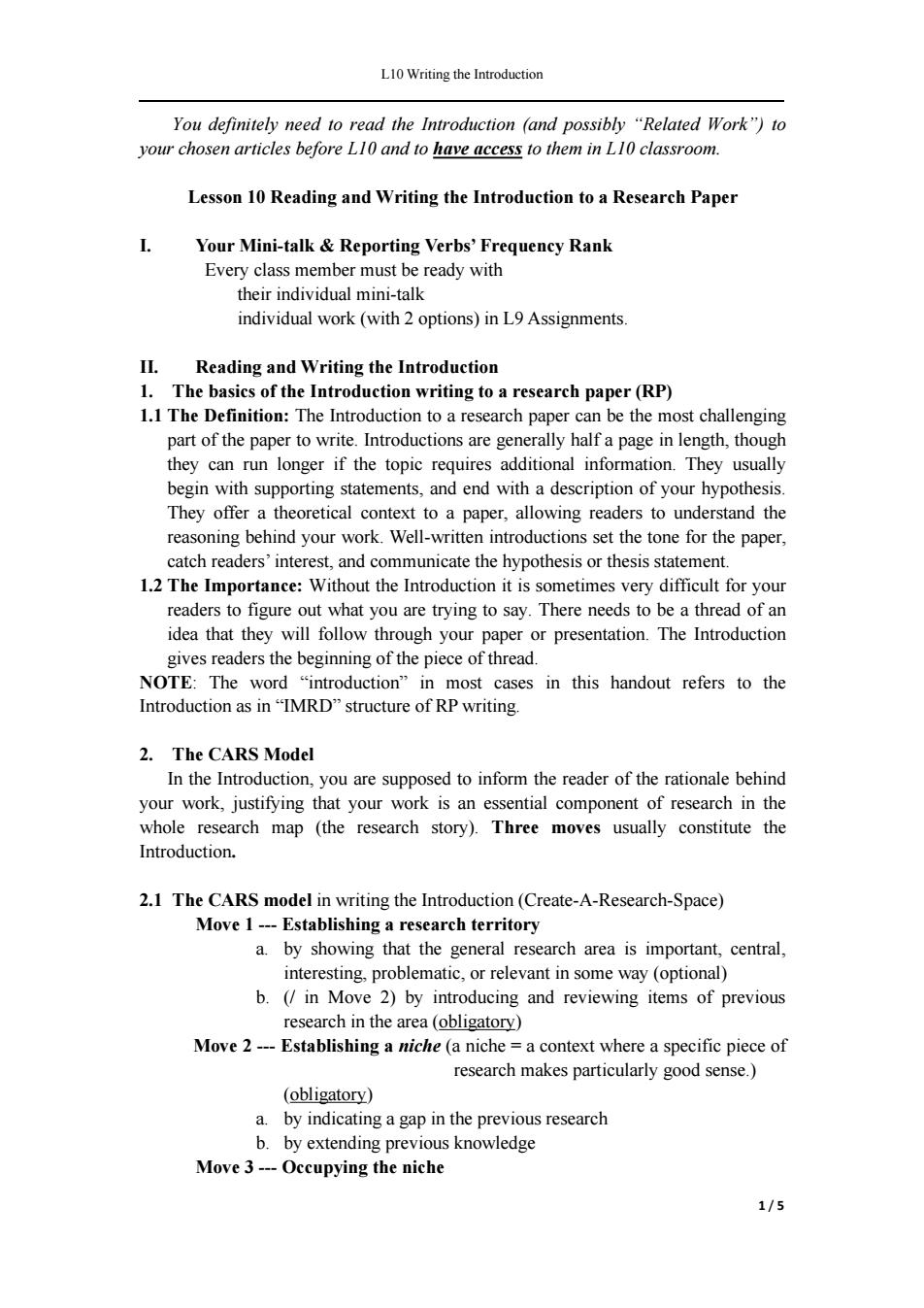正在加载图片...

L10 Writing the Introduction You definitely need to read the Introduction (and possibly "Related Work")to your chosen articles before L10 and to have access to them in L10 classroom. Lesson 10 Reading and Writing the Introduction to a Research Paper Your Mini-talk Reporting Verbs'Frequency Rank Every class member must be ready with their individual mini-talk individual work (with 2 options)in L9 Assignments. II.Reading and Writing the Introduction 1.The basics of the Introduction writing to a research paper(RP) 1.1 The Definition:The Introduction to a research paper can be the most challenging part of the paper to write.Introductions are generally half a page in length,though they can run longer if the topic requires additional information.They usually begin with supporting statements,and end with a description of your hypothesis. They offer a theoretical context to a paper,allowing readers to understand the reasoning behind your work.Well-written introductions set the tone for the paper, catch readers'interest,and communicate the hypothesis or thesis statement. 1.2 The Importance:Without the Introduction it is sometimes very difficult for your readers to figure out what you are trying to say.There needs to be a thread of an idea that they will follow through your paper or presentation.The Introduction gives readers the beginning of the piece of thread. NOTE:The word "introduction"in most cases in this handout refers to the Introduction as in"IMRD"structure of RP writing. 2.The CARS Model In the Introduction,you are supposed to inform the reader of the rationale behind your work,justifying that your work is an essential component of research in the whole research map (the research story).Three moves usually constitute the Introduction. 2.1 The CARS model in writing the Introduction(Create-A-Research-Space) Move 1---Establishing a research territory a.by showing that the general research area is important,central, interesting,problematic,or relevant in some way (optional) b.(in Move 2)by introducing and reviewing items of previous research in the area(obligatory) Move 2---Establishing a niche(a niche a context where a specific piece of research makes particularly good sense.) (obligatory) a.by indicating a gap in the previous research b.by extending previous knowledge Move 3---Occupying the niche 1/5L10 Writing the Introduction 1 / 5 You definitely need to read the Introduction (and possibly “Related Work”) to your chosen articles before L10 and to have access to them in L10 classroom. Lesson 10 Reading and Writing the Introduction to a Research Paper I. Your Mini-talk & Reporting Verbs’ Frequency Rank Every class member must be ready with their individual mini-talk individual work (with 2 options) in L9 Assignments. II. Reading and Writing the Introduction 1. The basics of the Introduction writing to a research paper (RP) 1.1 The Definition: The Introduction to a research paper can be the most challenging part of the paper to write. Introductions are generally half a page in length, though they can run longer if the topic requires additional information. They usually begin with supporting statements, and end with a description of your hypothesis. They offer a theoretical context to a paper, allowing readers to understand the reasoning behind your work. Well-written introductions set the tone for the paper, catch readers’ interest, and communicate the hypothesis or thesis statement. 1.2 The Importance: Without the Introduction it is sometimes very difficult for your readers to figure out what you are trying to say. There needs to be a thread of an idea that they will follow through your paper or presentation. The Introduction gives readers the beginning of the piece of thread. NOTE: The word “introduction” in most cases in this handout refers to the Introduction as in “IMRD” structure of RP writing. 2. The CARS Model In the Introduction, you are supposed to inform the reader of the rationale behind your work, justifying that your work is an essential component of research in the whole research map (the research story). Three moves usually constitute the Introduction. 2.1 The CARS model in writing the Introduction (Create-A-Research-Space) Move 1 --- Establishing a research territory a. by showing that the general research area is important, central, interesting, problematic, or relevant in some way (optional) b. (/ in Move 2) by introducing and reviewing items of previous research in the area (obligatory) Move 2 --- Establishing a niche (a niche = a context where a specific piece of research makes particularly good sense.) (obligatory) a. by indicating a gap in the previous research b. by extending previous knowledge Move 3 --- Occupying the niche